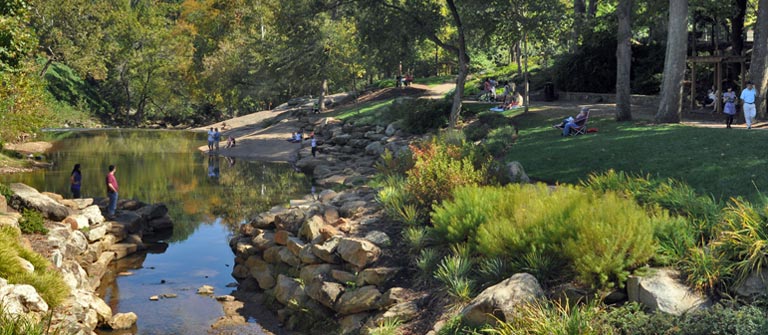The Story of Falls Park
To have played a key role in shaping Falls Park is one of the enduring achievements of Arbor Land Design. From the magnificent Liberty Bridge to the sweeping sidewalks, the vibrant blooms and the lush green spaces along the Reedy River, the Park has become Greenville’s “postcard.”
It stands as a living monument to what we believe great landscape architecture should be. Today, Falls Park is one of America’s best examples of how thoughtful Placemaking can bring a new spirit of civic consciousness to a community … and give it a great place to meet, relax and play.
A Vision Almost 100 Years in the Making
To be fair, Arbor Land Design wasn’t the first professional group to envision the possibilities of what having one of America’s only downtown waterfalls could mean for Greenville. A study completed by a Boston landscape architecture firm for the Greenville Municipal League in 1907 identified the falls as “the single feature to be considered in the development and beautifying of the city.”
Standing in the way was Camperdown Mill. Constructed in 1876, and at one point the second largest textile factory in the state, the mill stood adjacent to the falls. As more modern plants popped up around Greenville, Camperdown fell into disrepair and was eventually demolished in 1959. The very next year a four-lane bridge designed to provide a bypass of the central business district was erected across the Reedy River.
Although Greenville’s natural treasure was virtually obscured by the new bridge, the vision of what could be never went away. In 1967, the Carolina Foothills Garden Club acquired the 26 acres from Furman University that would become today’s Falls Park. A debate ensued between city leaders who envisioned something remarkable for Greenville and pragmatists who knew the value of the well-traveled Campderdown Bridge.
With Mayor Knox White leading the charge, renderings were created to show what a public park with the Falls as the centerpiece might look like. Convinced this had the potential to become the city’s new signature and revitalize the long-dormant West End, City Council voted to take down the Camperdown Bridge in 2001.
“Recommend Anything You Want. Just No Bridge.”
Greenville City Council trusted Arbor Land Design, not only to bring the park’s vision to reality, but to navigate the tricky waters of public opinion, particularly among those who questioned the wisdom of removing a serviceable bridge. The instructions to Arbor senior partner Tom Keith were simple. “We trust Arbor to create something amazing. Recommend anything you want; just no bridge. It’s too political.”
The Arbor team spent weeks walking the property to envision how to create an extraordinary park without fundamentally changing the natural contours of the land. Seeing the vertical terraces from street level all the way down to the riverbed, we understood the potential to create a series of adjoining spaces, connected by paths that allowed different ways to enter and leave the park.
As plans for the terraced spaces started to take shape, Arbor began to think about the waterfall itself. Walking the park over and over, we realized it was difficult to get the full impact of the true focal point of the park from the side. Only by traversing down to the base of the falls could a visitor have a different vantage point. But for disabled and older guests, that was an impossibility.
A pedestrian bridge seemed like the natural solution. It would provide a perfect view of the falls for young and old, while adding one more way to explore the park. To make the experience more compelling, Arbor felt a suspension bridge would create a sense of walking on air.
100 Years Later, The Falls Come Alive!
The plans for the park were approved and Arbor engaged internationally renowned architect Miguel Rosales to create the final design for what would become the Liberty Bridge and Falls Park. Named for Liberty Corporation, and its founder, Frank Hipp, the bridge is the only one of its kind in the United States. It has since received numerous awards for architecture and urban excellence.
The Park opened on September 10, 2004. In the years that have followed, tens of thousands have walked across Liberty Bridge; experienced the power of the waterfall after a heavy rainfall; inhaled the fragrance of nature constantly in bloom; and loved the feeling of plush grass between your toes.
Falls Park has become home to dozens of events throughout the year, from the Duck Derby to Artisphere to Shakespeare in the Park. But in truth, Falls Park has truly become Greenville’s own beautiful back yard. Envisioned with the same sense of “place” that is the foundation of all Arbor work, the Park brings people from all walks of life together in a spirit of joy, respect and inclusion.
It is Greenville at its best.


